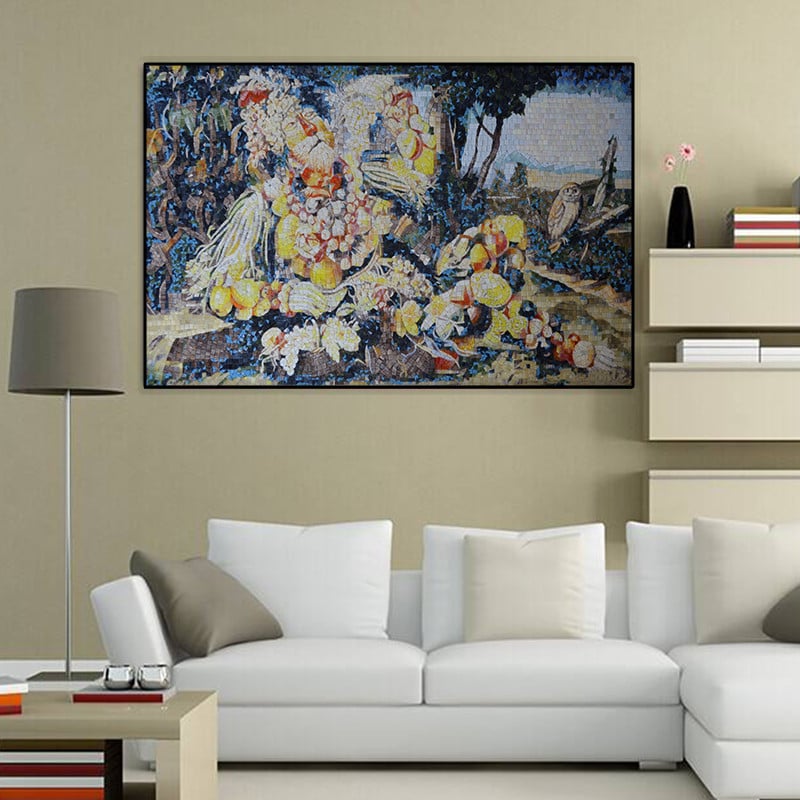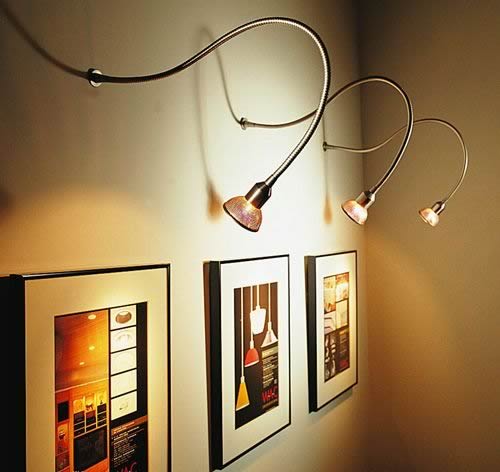MAKING YOUR ART SHINE: LIGHTING TECHNIQUES TO SPOTLIGHT YOUR MASTERPIECES
(3 min read) Lighting artwork, especially mosaics that may be composed of various materials, can be tricky but there are a few basic rules to make your masterwork shine.
Before considering your lighting options, you should ensure that any paintings are placed away from windows as ultraviolet rays can cause fading and discoloration. Marble Tile Mosaics on the other hand won’t fade even if placed outside.
The first factor to consider is, do you wish to put the spotlight on the artwork to make it a focal point or your priority is to have a well-lit room and have the artwork just be an element of your decor. If your priority is for the painting to be a centerpiece, you want to avoid a “flat” effect by using only diffuse lights. Instead chose the most important spots in your room and add some accent lights to add atmosphere to your space. Your artwork can be one of these “accents” or be framed by these spots of lights as in the example below.

If you would like to add particular emphasis on your painting, sculpture or mosaic for dramatic effect you will need to use one or more spotlights and have them be roughly three times as bright as the remaining lights in the room.

Next comes to the actual choice of lights. Regardless of the type of artwork you have, high-quality LEDs are a preferred solution for a few reasons:
- LEDs don’t emit harmful UV rays or infrared light. This may not be important for mosaics or sculptures but it is crucial for paintings that would otherwise be damaged over time.
- High-quality LEDs (with a color temperature of 2,700K) will make the colors appear more vibrant.
- Though they carry a higher price tag they will save you money over time.
If you decide to go with halogen lights instead, you should be particularly careful not to place them too close to paintings or drawings as the heat can damage them. A simple test is to hold your hand up to the artwork. If you can feel the heat from the light it needs to be placed further away. You should also add a UV filter for protection.
Incandescent lights are also an acceptable solution as their warmer tones can work well for certain pieces but here too you should ensure that the source is far enough to avoid any heat damage.
Fluorescent lights, on the other hand, should be avoided as they distort colors and emit a high level of ultraviolet rays.
So let’s look at some available light sources.
Diffuse Lights: These are non-accentuated ceiling lights or floor lamps that light a space in an even manner by bouncing light off the ceiling and walls. In this instance there are no obvious light sources and the space can feel flat or bland. Ideally, one or more secondary light sources are used to highlight the artwork or other important elements in your room to add atmosphere.

Ceiling-mounted accent lights: Pin spotlights (surface mounted or recessed) are ideal to add highlights. As a rule of thumb, the light beam should be focused so that it hits the center of the artwork at a 30-degree angle. Steeper angles would mute the colors and would create long shadows of the frame or sculpture. Note that you can change the angle slightly to bring out textures should you wish to. Varying the angle by 5-10 degrees for mosaics with a crazy cut finish, for example, can enhance the “rough” effect seen in the example below.

Wider angles will often create unwanted reflections on polished surfaces like glass. Using non-reflective glass for paintings will help reduce the effect but for mosaics with polished surfaces (like glass or metal) finding the right angle is crucial.

The spread (area lit by the beam) should be adjusted to cover most of the artwork. For sculptures, an additional backlight ie a light placed behind the object can help separate it from the background. You may even consider placing a third light source on one of the sides of the sculpture, slightly higher than its center, to soften some of the shadows and create a truly three-dimensional effect.



Tracking Lights: These can be used in a similar fashion to ceiling-mounted lights but have the advantage of being easier to install and adjust. Track lights come in such a variety of styles that you should be able to find one that fits your current decor be it classic or contemporary. The right ones can be quite stylish and become part of your decor.
Picture Lights: These types of lights are mounted directly above the artwork or on the frame itself if the frame is big enough to support it. It’s a technique often used in museums but with the right type of intensity, it can create a very intimate effect. These lights too come in a variety of shapes and styles but require a nearby outlet or to be installed on the wall. As you can see putting some thought into lighting your art piece can really pay off and make you fall in love with it all over again. If you are interested in seeing a fascinating example of museum lighting check out this short video from the Smithsonian. It shows art coming to life as the various lights come on. So make those beloved pieces shine as you ring in the New Year and may your 2018 be full of joy and wonderful art.
Like this? Please share and “SUBSCRIBE” to catch the next one. Follow our story as it unfolds on Instagram | Facebook | Twitter | Pinterest We add new works everyday, check our latest Mosaic Art collection.






